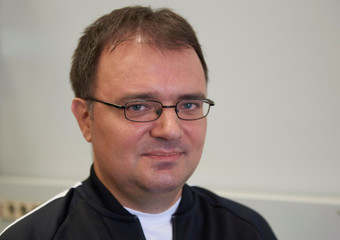Der Inhalt dieser Seite ist leider nur auf Englisch verfügbar.
Ante Bilandzic receives ERC research grant
EU is funding research on quark gluon plasma
2017-09-05 – News from the Physics Department
A quark-gluon plasma (QGP) is the state of matter that is believed to have existed for a fraction of a millisecond after the Big Bang. Just for a very short period of time temperature and density were so extremely high that quarks and gluons were bound only weakly, and moved freely on their own in this state of matter that is called quark-gluon plasma. On the universe’s subsequent rapid expansion and cooling the gluons, as carriers of the strong force, ‘glue’ the quarks together into familiar neutrons and protons and other species of ‘ordinary matter’.
In order to recreate and study conditions similar to those of the very early universe, powerful particle accelerators fuel head-on collisions of massive ions, such as gold or lead nuclei at high, at relativistic speeds. The Large Hadron Collider (LHC) at CERN sets the current record energy at around 5 TeV per nucleon pair for heavy ion collisions. These collisions (in fact millions of such collisions are studied and analyzed) form a minuscule, but extremely hot fireball in which the atomic nuclei “melt” into a primordial quark-gluon plasma.
As the fireball instantly expands, the individual quarks and gluons combine into a storm of ordinary matter that speeds away in all directions. This debris is analyzed at huge detectors, like the ALICE detector at the LHC. Previous studies have shown that the QGP behaves like a strongly coupled liquid, rather than as a weakly interacting gas, as had been expected by theorists.
Ante Bilandzic’s expertise is in analyzing the huge amounts of data gathered at the experiments at CERN with multi-particle correlation techniques. With his methods the properties of the QGP are pinned down quantitatively. Ante Bilandzic has worked both as a theorist and experimentalist and both types of physicists will make up his team. They aim on taking the chance of the recent restart of the LHC for heavy ion beams to scrutinize the formation of the QGP at a higher energy range than previously possible. With techniques developed within the group, they will study the collective anisotropic flow properties of the QGP.
An interdisciplinary subproject “Quest for the hyperons and Quark-Gluon Plasma in the core of neutron stars” will be performed as a part of the collaborative research center SFB 1258 Dark Matter and Neutrinos.
Obviously, Ante Bilandzic is very happy about this grant: “I am really looking forward to utilizing this grant at TUM, because for me it is a very inspiring place to perform research in fundamental science. In particular, I am very grateful to Prof. Laura Fabbietti and her research group at the Physics Department for their always encouraging support.” He would also like to thank many collaborators at the ALICE experiment at CERN.
Ante Bilandzic studied physics at the universities of Zagreb, Croatia and Utrecht, The Netherlands before completing his PhD in 2012 at the Nikhef Institute, Amsterdam, The Netherlands, supervised by Prof. Dr. Raimond Snellings. During his PhD he stayed at CERN, Geneva for a year. After a post-doc at the Niels Bohr Institute, Copenhagen, he joined the research group of Prof. Laura Fabbietti at TUM’s Physics Department in 2015.
